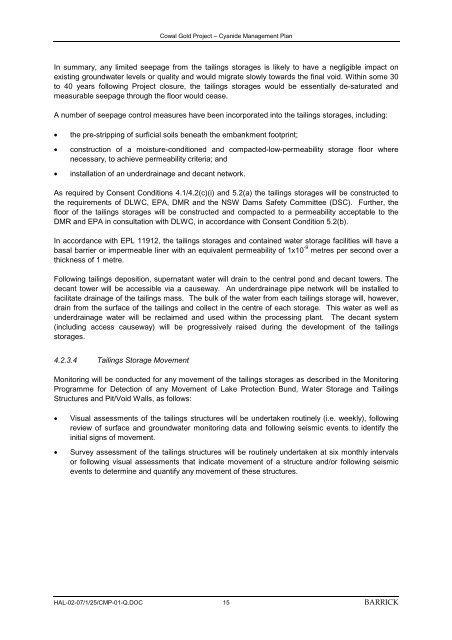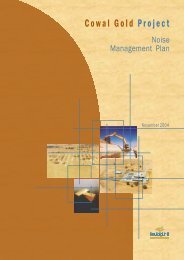January 2006 (PDF 2.9 MB) - Barrick Gold Corporation
January 2006 (PDF 2.9 MB) - Barrick Gold Corporation
January 2006 (PDF 2.9 MB) - Barrick Gold Corporation
Create successful ePaper yourself
Turn your PDF publications into a flip-book with our unique Google optimized e-Paper software.
Cowal <strong>Gold</strong> Project – Cyanide Management Plan<br />
In summary, any limited seepage from the tailings storages is likely to have a negligible impact on<br />
existing groundwater levels or quality and would migrate slowly towards the final void. Within some 30<br />
to 40 years following Project closure, the tailings storages would be essentially de-saturated and<br />
measurable seepage through the floor would cease.<br />
A number of seepage control measures have been incorporated into the tailings storages, including:<br />
• the pre-stripping of surficial soils beneath the embankment footprint;<br />
• construction of a moisture-conditioned and compacted-low-permeability storage floor where<br />
necessary, to achieve permeability criteria; and<br />
• installation of an underdrainage and decant network.<br />
As required by Consent Conditions 4.1/4.2(c)(i) and 5.2(a) the tailings storages will be constructed to<br />
the requirements of DLWC, EPA, DMR and the NSW Dams Safety Committee (DSC). Further, the<br />
floor of the tailings storages will be constructed and compacted to a permeability acceptable to the<br />
DMR and EPA in consultation with DLWC, in accordance with Consent Condition 5.2(b).<br />
In accordance with EPL 11912, the tailings storages and contained water storage facilities will have a<br />
basal barrier or impermeable liner with an equivalent permeability of 1x10 -9 metres per second over a<br />
thickness of 1 metre.<br />
Following tailings deposition, supernatant water will drain to the central pond and decant towers. The<br />
decant tower will be accessible via a causeway. An underdrainage pipe network will be installed to<br />
facilitate drainage of the tailings mass. The bulk of the water from each tailings storage will, however,<br />
drain from the surface of the tailings and collect in the centre of each storage. This water as well as<br />
underdrainage water will be reclaimed and used within the processing plant. The decant system<br />
(including access causeway) will be progressively raised during the development of the tailings<br />
storages.<br />
4.2.3.4 Tailings Storage Movement<br />
Monitoring will be conducted for any movement of the tailings storages as described in the Monitoring<br />
Programme for Detection of any Movement of Lake Protection Bund, Water Storage and Tailings<br />
Structures and Pit/Void Walls, as follows:<br />
• Visual assessments of the tailings structures will be undertaken routinely (i.e. weekly), following<br />
review of surface and groundwater monitoring data and following seismic events to identify the<br />
initial signs of movement.<br />
• Survey assessment of the tailings structures will be routinely undertaken at six monthly intervals<br />
or following visual assessments that indicate movement of a structure and/or following seismic<br />
events to determine and quantify any movement of these structures.<br />
HAL-02-07/1/25/CMP-01-Q.DOC 15 BARRICK

















